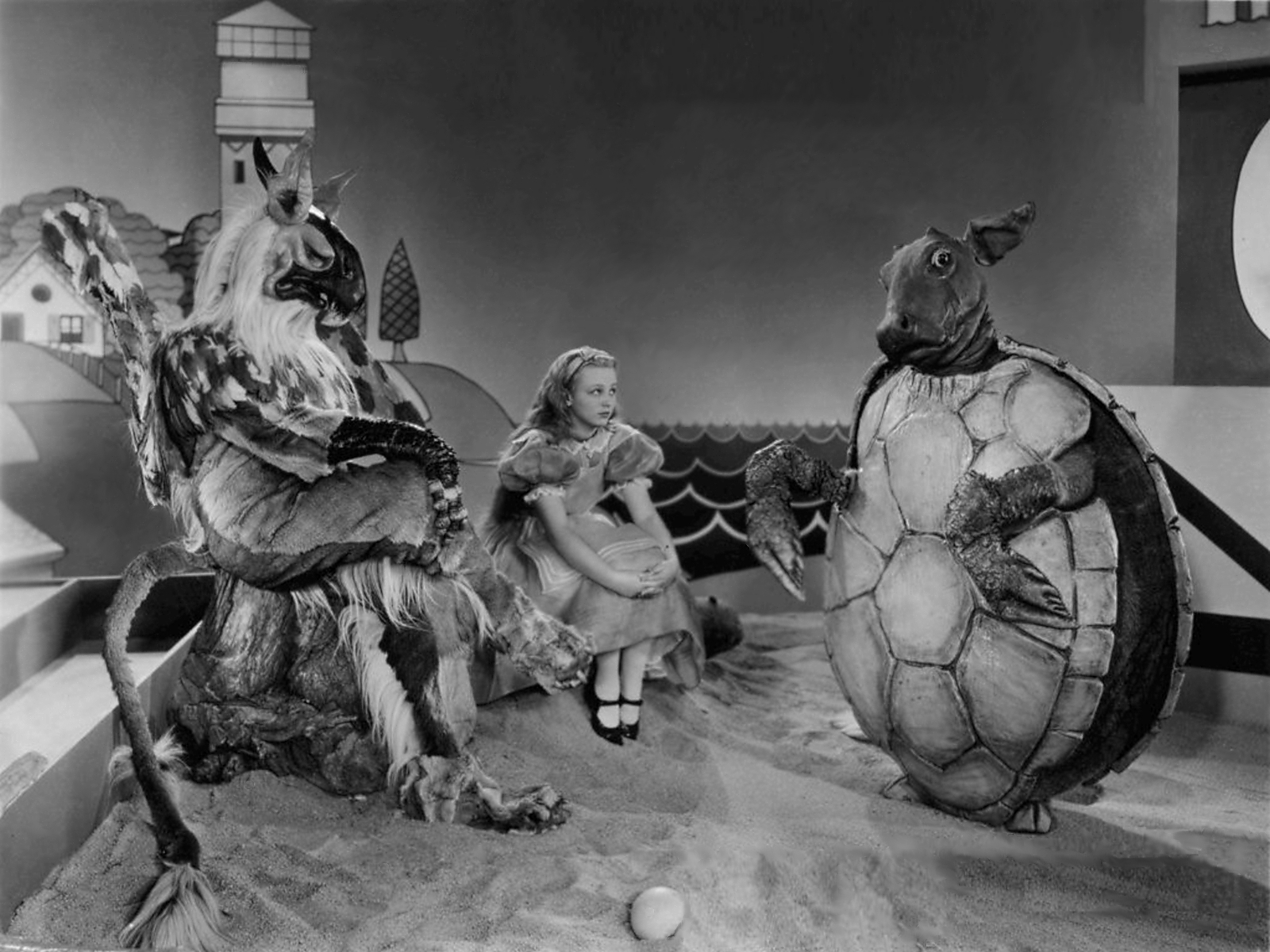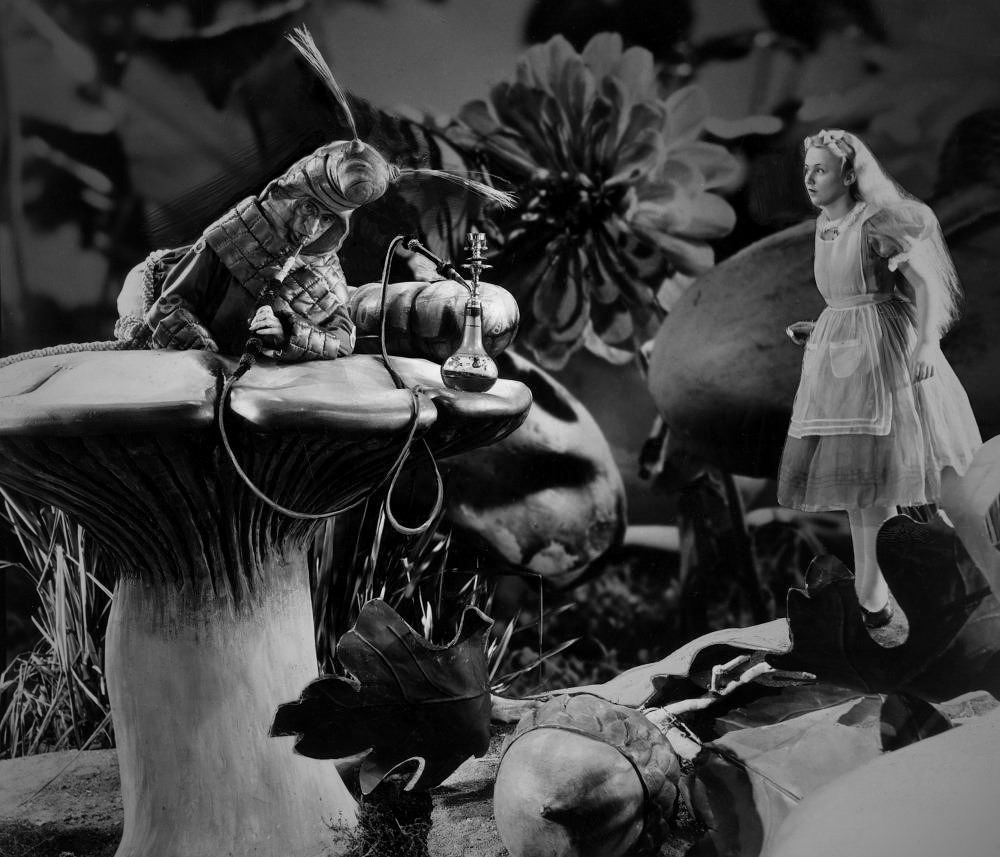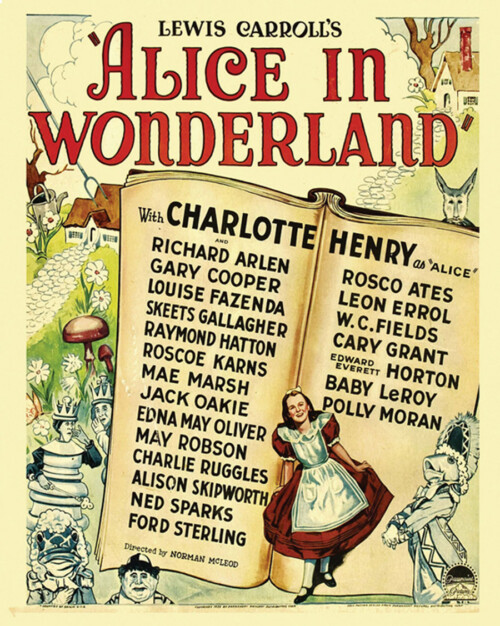USA. 1933.
Crew
Director – Norman McLeod, Screenplay – Joseph L. Mankiewicz & William Cameron Menzies, Based on the Novels Alice’s Adventures in Wonderland and Through the Looking Glass by Lewis Carroll, Photography (b&w) – Bert Glennon & Henry Sharp, Music – Dimitri Tiomkin, Music Director – Nathaniel Finston, Technical Effects – Farciot Edouart & Gordon Jennings, Settings – Robert Odell. Production Company – Paramount.
Cast
Charlotte Henry (Alice), May Robson (Queen of Hearts), Louis Fazenda (White Queen), Richard Arlen (Cheshire Cat), Gary Cooper (White Knight), W.C. Fields (Humpty Dumpty), Edward Everett Horton (Mad Hatter), Ned Sparks (Caterpillar), Jackie Oakie (Tweedledum), Roscoe Karns (Tweedledee), Skeets Gallagher (Rabbit), Charlie Ruggles (March Hare), Raymond Hatton (Mouse), Alec B. Francis (King of Hearts), Ford Sterling (White King), Alison Skipworth (Duchess), Polly Moran (Dodo Bird), Jackie Searl (Dormouse), Cary Grant (Mock Turtle), Mae Marsh (Sheep)
Plot
Young Alice walks through of a mirror into the world on the other side where she finds a place populated by a bewildering array of talking creatures and nonsense rhymes.
Alice in Wonderland was the first major sound adaptation of the Lewis Carroll book. At that point, It was the fifth film overall to have been made of the book). There had been an earlier short sound version made in 1931 but this appears to be lost. Many early sound era films were merely variations on radio variety shows. Alice in Wonderland was regarded as an all-star spectacle in this regard, bringing together comics of the era like Charlie Ruggles, W.C. Fields, Baby Le Roy and stars such as Cary Grant, Gary Cooper, Edward Everett Horton and Sterling Holloway in bit parts. The 1933 version is usually regarded as a lumbering, stagebound spectacle but to raise the spectre of contrary opinion, this author rather liked it.
Certainly, the film treats the book liberally, mixing elements from Alice’s Adventures in Wonderland (1865) and Through the Looking Glass (1871) all over the place – the film begins, for example, not with the famous scene where Alice follows the White Rabbit down a hole (although this scene does occur in the middle of the film) but by walking through the mirror, the less-remembered opening from Through the Looking Glass. This freewheeling attitude toward the book annoyed many Lewis Carroll purists. On the whole though, this is not too bad an adaptation. It is otherwise surprisingly faithful to the spirit of Lewis Carroll and finds a visual equivalent of the nonsense poetry, unlike the stumbling literalisations of many other adaptations.

Far more crippling are the drab and dumpy costumes that the cast are outfitted with, which look exactly like actors kitted out in ill-fitting costumes. Nevertheless, some of the character set-pieces come off well – the ones we are used to like the Red Queen’s croquet game (which is conducted somewhat ungainily using real flamingos), The Mad Hatter’s Tea Party, the Cheshire Cat – and some we are less used to – the encounters with Humpty Dumpty and Tweedledum and Tweedledee. Especially good is Gary Cooper’s White Knight.
The film was made in an era (the 1930s) when fantasy – even in fantastic cinema – remained resolutely prosaic and pedestrian. The film should be noted for its willingness to let the fantasy fly with all the nonsense absurdism of Lewis Carroll – Alice floats down the stairs and literally drowns in her tears. The climax is a memorably surrealistic set-piece featuring talking roasts and pudding and a banquet of flying teapots. The opening with Alice stepping in through the looking glass and finding a mirror-reversed room and the backs of the photos that hang on the wall is quite magical. The shrinking and enlarging effects are conducted with effective simplicity.
Director Norman [Z.] McLeod was a classic comedy director of the 1930s and 40s. He made early Marx Brothers films such as Monkey Business (1931) and Horse Feathers (1932), It’s a Gift (1934) with W.C. Fields and Road to Rio (1947), the fifth of the Bob Hope-Bing Crosby Road movies. In genre material, McLeod also made the ghost screwball comedy Topper (1937) and its sequel Topper Takes a Trip (1938), and the Danny Kaye daydreamer fantasy The Secret Life of Walter Mitty (1947).

The other screen adaptations of Alice in Wonderland are:- Alice in Wonderland (1903), a silent British short; Alice’s Adventures in Wonderland (1910), a silent American short; Alice in Wonderland (1915); Alice Through the Looking Glass (1928); Alice in Wonderland (1931), the first sound version; the partly stop-motion animated French Alice in Wonderland (1949); the classic Disney animated version Alice in Wonderland (1951); the NBC tv version Alice in Wonderland (1955); the modernised Hanna-Barbera animated tv special Alice in Wonderland, or What’s a Nice Kid Like You Doing in a Place Like This? (1966); the NBC tv production Alice Through the Looking Glass (1966); the all-star British film Alice’s Adventures in Wonderland (1972) featuring Michael Crawford, Ralph Richardson, Peter Sellers, Spike Milligan and Dudley Moore; the BBC tv production Alice Through the Looking Glass (1974); the Italian tv mini-series In the World of Alice (1974); a 1976 Argentinean film version; a pornographic version Alice in Wonderland (1976); a Spanish film version Alice in Spanish Wonderland (1979); the Belgian film Alice (1982), which features equivalents of the Wonderland characters in the modern world; a US tv production Alice in Wonderland (1982); a US tv version Alice at the Palace (1982) with Meryl Streep as Alice; a BBC musical version A Dream of Alice (1982) with Jenny Agutter as Alice; a British tv series Alice in Wonderland (1985); Irwin Allen’s all-star tv mini-series Alice in Wonderland (1985) featuring Roddy McDowall, Telly Savalas and Shelley Winters; a BBC tv series Alice in Wonderland (1986); the animated Alice Through the Looking Glass (1987); having been combined with the Care Bears in the animated The Care Bears Adventure in Wonderland (1987); Jan Svankmajer’s bizarrely brilliant Claymation animated Alice (1988); Woody Allen’s modernised urban spin Alice (1990); the US tv series Alice in Wonderland (1991); the British tv version Alice Through the Looking Glass (1998) with Kate Beckinsale as Alice and an all-star cast; the Hallmark tv version Alice in Wonderland (1999) with Tina Majorino as Alice and an all-star cast; Alice’s Misadventures in Wonderland (2004), a modernised indie film take on the story; Alice (2009), a modernised tv mini-series starring Caterina Scorsone as Alice entering into a dark science-fictional wonderland; Malice in Wonderland (2009), a modernised British film that translates Wonderland into an urban environment; Alice in Murderland (2010), an Alice in Wonderland-themed slasher film; Tim Burton’s big budget Alice in Wonderland (2010) and its sequel Alice Through the Looking Glass (2016); Alyce (2011), another modernised urban translation; the modernised tv series Once Upon a Time in Wonderland (2013-4); The Other Side of the Mirror/Alice: The Darker Side of the Mirror (2016), a dark retelling; and the horror version Alice in Terrorland (2023). Also of note is Dennis Potter’s tv play Alice (1965), which explores Lewis Carroll’s relationship with Alice Liddell, the young girl who became the model for Alice, and the later film Dreamchild (1985) in which the real-life Alice reminisces back on her memories of Lewis Carroll and the writing of the story.
Trailer here


